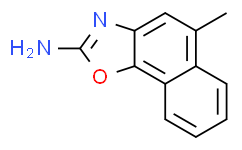| DC73675 |
VU0546110
|
VU0546110 (VU 0546110) is a potent, selective inhibitor of the sperm-specific potassium channel SLO3 with IC50 of 1.29 uM, impairs sperm function. |
| DC73665 |
KCNQ2 activator Ebio1
|
Ebio1 is a selective voltage-gated potassium channel KCNQ2 activator. Ebio1 activates KCNQ2 by generating an extended channel gate with greater conductance at a saturation voltage (+50 mV). |
| DC70890 |
VU0606170
|
VU 0606170 (also referred to as VU0606170) is a selective inhibitor of the sodium-activated potassium channel KNa1.1, also known as Slack or Slo2.2. This compound has shown specificity for Slack channels over other related potassium channels, making it a valuable tool for studying the physiological and pathological roles of KNa1.1. |
| DC70574 |
Lu AA41178
|
Lu AA41178 is a potent, pan-selective Kv7.2-7.5 opener with EC50 of 1.5, 0.6 20.5, and 37.0 uM for Kv7.2, Kv7.2/7.3, Kv7.4 and Kv7.5, respectively.Lu AA41178 displays no activity at Kv7.1 channels, has no potentiating impact on currents through GABAA ion channels, and a clean off-target profile against common cardiac ion channels.Lu AA41178 significantly increased the seizure thresholds in mice, demonstrating anticonvulsant efficacy in the maximum electroshock seizure threshold test and PTZ seizure threshold test.Lu AA41178 demonstrated antipsychotic-like activity by reducing amphetamine-induced hyperlocomotion in mice as well as lowering conditioned avoidance responses in rats, significantly reduced immobility in mouse model with antidepressant predictivity. |
| DC70426 |
GAT1508
|
GAT1508 (GAT-1508) is a potent, specific activator for brain-expressed GIRK1/2 channels (EC50=75 nM), specifically activates the brain GIRK1/2 over the cardiac GIRK1/4;
GAT1508 is an allosteric modulator of channel–phosphatidylinositol 4,5-bisphosphate interactions.
GAT1508 effectively extinguished conditioned fear in rodents and lacked cardiac and behavioral side effects, suggesting its potential for use in pharmacotherapy for post-traumatic stress disorder. |
| DC70327 |
CTIBD
|
CTIBD is a novel potent activator of the BKCa channel with EC50 of 3.9 uM.CTIBD showed significantly higher potency compared with three other known BKCa activators: NS 1619, NS 11021, and rottlerin.CTIBD induced a reversible potentiation of macroscopic outward currents of the BKCa channel, CTIBD activates both rSlo/rβ1 and rSlo/rβ4 coexpressed channels mainly by decreasing the closing rate of the channel.CTIBD concentration-dependently reduced ACh-induced contractions in isolated rat urinary bladder strips. CTIBD effectively restored frequent voiding contraction and lowered voiding volume without affecting other bladder function parameters in acetic acid-induced overactive bladder (OAB) model (i.p. 20 mg/kg). |
| DC48873 |
DPO-1
|
DPO-1 is a potent inhibitor of the voltage-gated potassium channel subtype Kv1.5 and a blocker of ultrarapid delayed rectifier potassium current. DPO-1 prevents atrial arrhythmia. |
| DC47376 |
Rimtuzalcap
|
Rimtuzalcap (CAD-1883) is a first-in-class selective positive allosteric modulator of small-conductance calcium-activated potassium channels (SK channels). Rimtuzalcap can be used for the research of movement disorders including essential tremor (ET) and spinocerebellar ataxia (SCA). |
| DC41224 |
Minoxidil sulfate
|
Minoxidil sulfate, a potent and ATP-sensitive K+ channel opener, is the sulfated metabolite of minoxidil. Minoxidil sulfate is considered as a vasodilator to promote hair growth in vivo. |
| DC41048 |
A2793
|
A2793 is an efficient TWIK-related acid-sensitive K+ channel (TASK)-1 inhibitor, with an IC50 of 6.8 μM. |






















